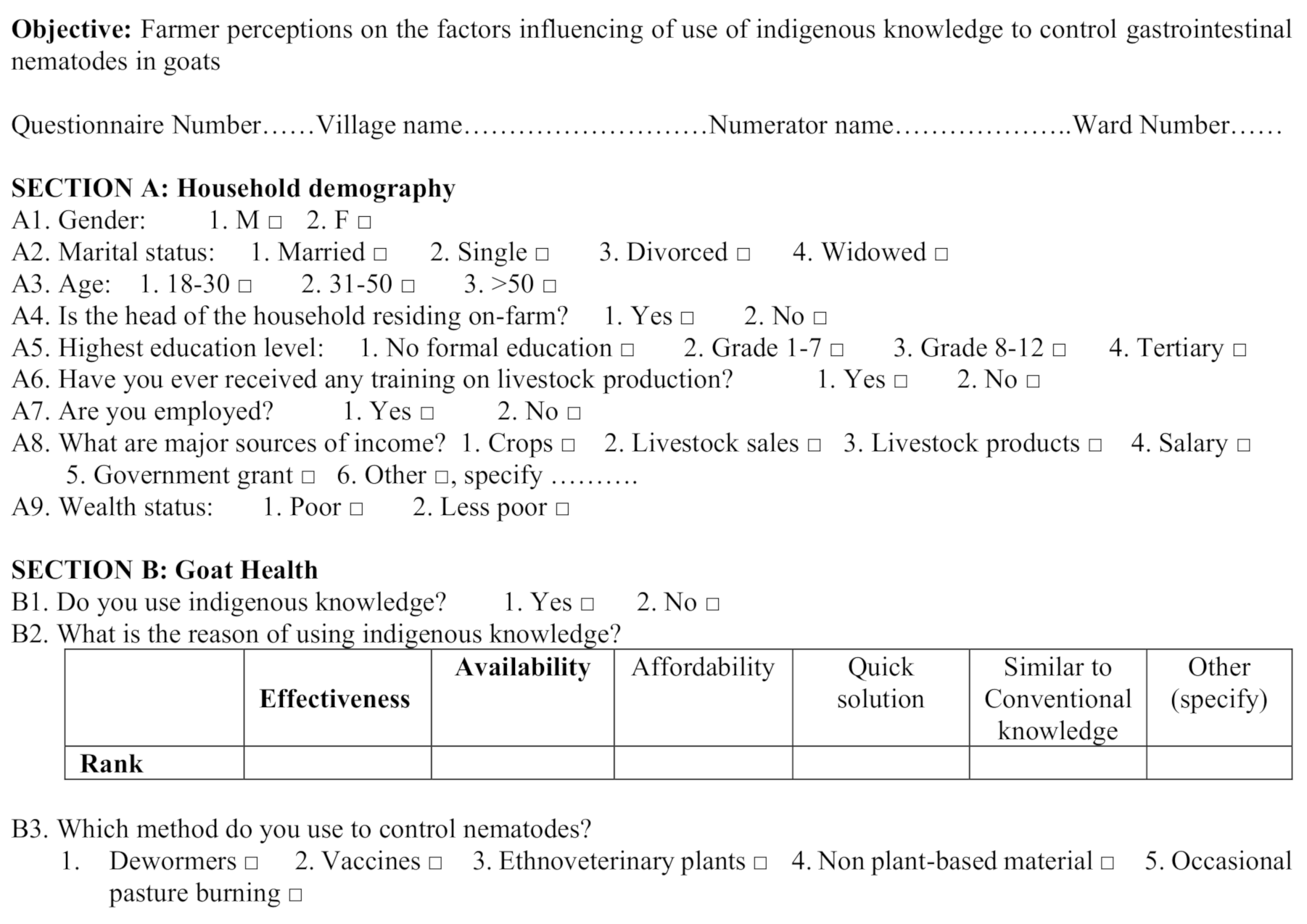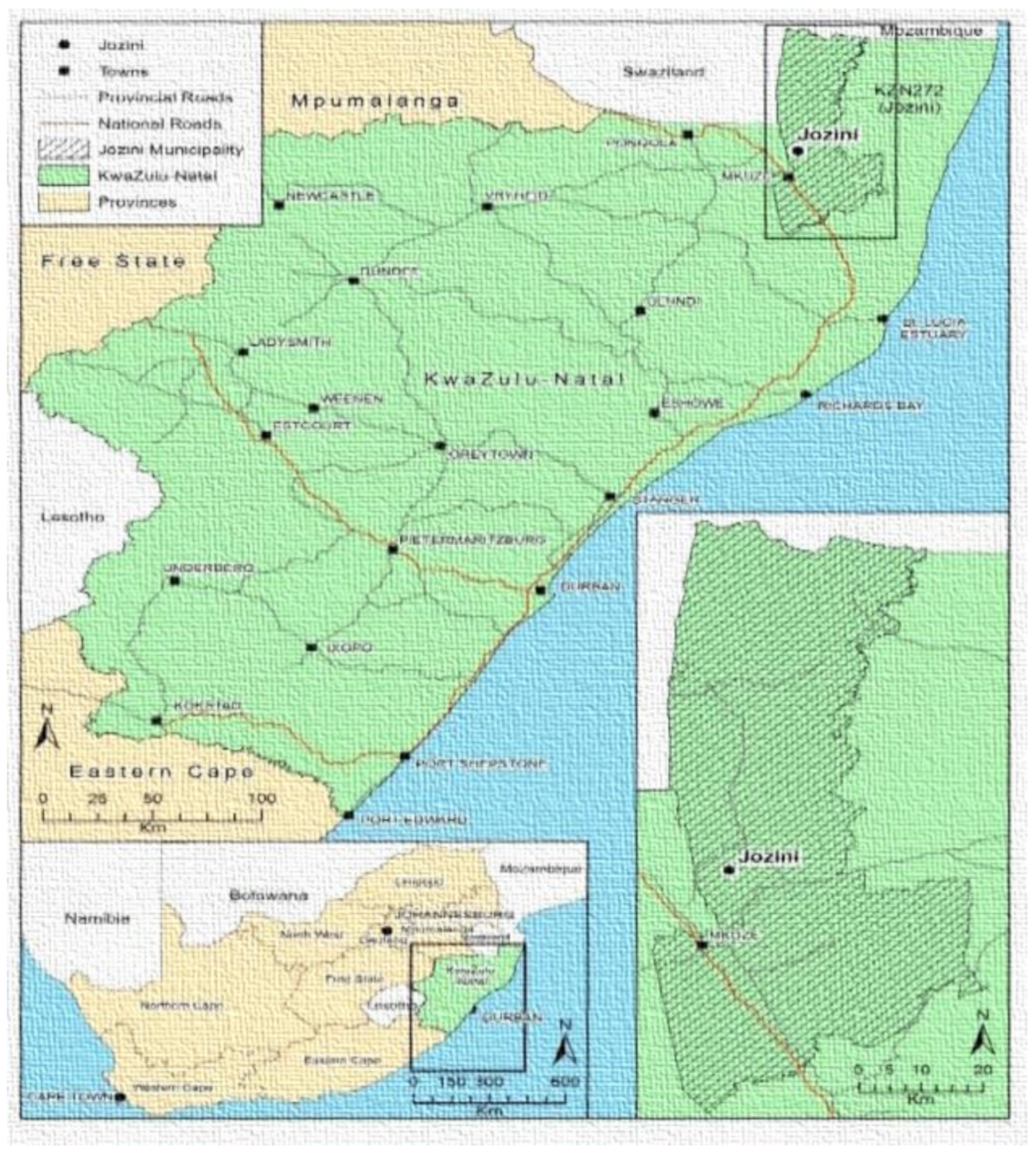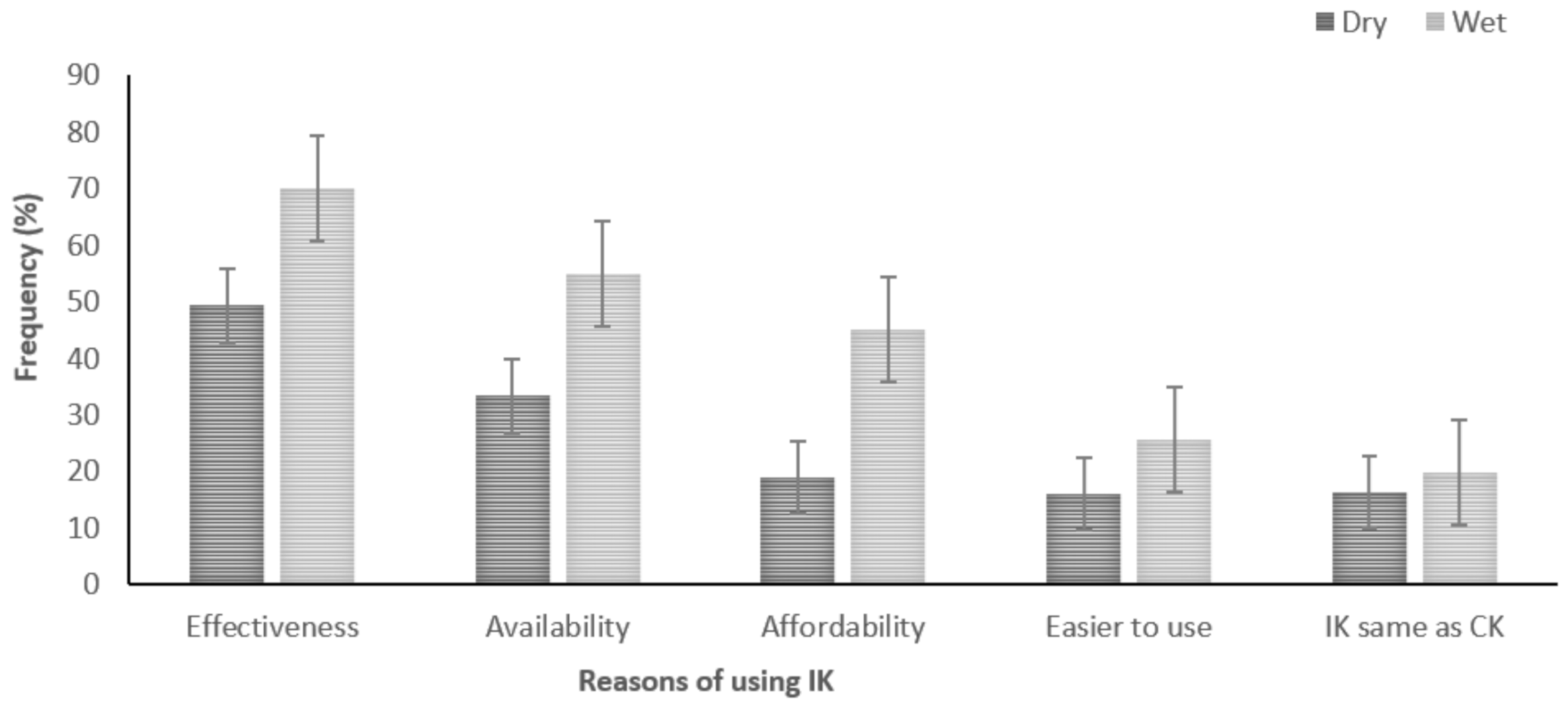Factors Affecting Utilisation of Indigenous Knowledge to Control Gastrointestinal Nematodes in Goats
Abstract
1. Introduction
2. Materials and Methods
2.1. Ethical Clearance
2.2. Description of Study Site
2.3. Data Collection
2.4. Statistical Analyses
3. Results
3.1. Household Demographic Information
3.2. Reasons of Using Indigenous Knowledge
3.3. Indigenous and Conventional Methods Used to Control Nematodes
3.4. Odds Ratio Estimates of the Factors Influencing IK Use to Control Nematodes in Goats
4. Discussion
5. Conclusions
Author Contributions
Funding
Data Availability Statement
Acknowledgments
Conflicts of Interest
Appendix A

References
- Skapets, B.; Bampidis, V. Goat Production in the World: Present Situation and Trends. Livest. Res. Rural. 2016, 28, 200. Available online: http://www.lrrd.org/lrrd28/11/skap28200.html (accessed on 29 April 2019).
- Ngambi, J.W.; Alabi, O.J.; Norris, D. Role of goats in food security, poverty alleviation and prosperity with special reference to Sub-Saharan Africa: A review. Indian J Anim Sci. 2013, 47, 1–9. [Google Scholar]
- Mdletshe, Z.M.; Ndlela, S.Z.; Nsahlai, I.V.; Chimonyo, M. Farmer perceptions on factors influencing water scarcity for goats in resource-limited communal farming environments. Trop. Anim. Health Prod. 2018, 50, 1617–1623. [Google Scholar] [CrossRef] [PubMed]
- Durawo, C.; Zindove, T.J.; Chimonyo, M. Influence of genotype and topography on the goat predation challenge under communal production systems. Small Rumin. Res. 2017, 149, 115–120. [Google Scholar] [CrossRef]
- Zvinorova, P.I.; Halimani, T.E.; Muchadeyi, F.C.; Matika, O.; Riggio, V.; Dzama, K. Prevalence and risk factors of gastrointestinal parasitic infections in goats in low-input low-output farming systems in Zimbabwe. Small Rumin. Res. 2016, 143, 75–83. [Google Scholar] [CrossRef]
- Atanásio-Nhacumbel, A.; Sitoe, C.F. Prevalence and seasonal variations of eggs of gastrointestinal nematode parasites of goats from smallholder farms in Mozambique. Insight Vet. Sci. 2019, 3, 23–29. [Google Scholar] [CrossRef]
- Kebede, A. Review on anthelmintic drug resistance nematodes and its methods of detection in Ethiopia. J. Vet. Med. Anim. Sci. 2019, 2, 1013. [Google Scholar]
- Kaplan, R.M.; Vidyashamkar, A.N. An inconvenient truth: Global warming and anthelmintic resistance. Vet. Parasitol. 2012, 186, 70–78. [Google Scholar] [CrossRef] [PubMed]
- Weckmüller, H.; Barriocanal, C.; Maneja, R.; Boada, M. Factors affecting traditional medicinal plant knowledge of the Waorani, Ecuador. Sustainability 2019, 11, 4460. [Google Scholar] [CrossRef]
- Mkwanazi, M.V.; Ndlela, S.Z.; Chimonyo, M. Utilisation of indigenous knowledge to control ticks in goats: A case of KwaZulu-Natal Province, South Africa. Trop. Anim. Health Prod. 2020. [Google Scholar] [CrossRef]
- Cunningham, A.B. African Medicinal Plants; United Nations Educational, Scientific and Cultural Organization: Paris, France, 1993. [Google Scholar]
- Matavele, J.; Habib, M. Ethnobotany in Cabo Delgado, Mozambique: Use of medicinal plants. Environ. Dev. Sustain. 2000, 2, 227–234. [Google Scholar] [CrossRef]
- Hunn, E.S. Evidence for the precocious acquisition of plant knowledge by Zapotec children. Ethno. Bio. Div. 2002, 604, 13. [Google Scholar]
- Gush, M. Measurement of water use by Jatropha curcas L. using the heat pulse velocity technique. Water SA 2008, 34, 579–583. [Google Scholar] [CrossRef]
- Morgenthal, T.L.; Kellner, K.; van Rensburg, L.; Newby, T.S.; van der Merwe, J.P.A. Vegetation and habitat types of the UMkhanyakude Node. S. Afr. J. Bot. 2006, 72, 1–10. [Google Scholar] [CrossRef]
- Botha, A.F.; Roux, J.A. Fibre, yarn and fabric properties of South African indigenous goat hair. In Proceedings of the 4th International Cashmere/wool Technique Symposium, Erdos City, China, 17–18 November 2008; pp. 140–147. [Google Scholar]
- Ndawonde, B.G. Medicinal Plant Sales: A Case Study in Northern Zululand. MSc Thesis, University of Zululand, KwaDlangezwa, South Africa, 2006. [Google Scholar]
- Vilakazi, B.S.; Zengeni, R.; Mafongoya, P. Indigenous strategies used by selected farming communities in KwaZulu Natal, South Africa, to manage soil, water, and climate extremes and to make weather predictions. Land Degrad Dev. 2019, 30, 1999–2008. [Google Scholar] [CrossRef]
- Jenjezwa, V.R.; Seethal, C.E.P. The role of the state in stock farming in rural areas: A case study of Hertzog, Eastern Cape, South Africa. JSAVA 2014, 85, 1–7. [Google Scholar] [CrossRef] [PubMed][Green Version]
- Hussain, A.; Khan, M.N.; Iqbal, Z.; Sajid, M.S. An account of the botanical anthelmintics used in traditional veterinary practices in Sahiwal district of Punjab, Pakistan. J. Ethnopharmacol. 2008, 119, 185–190. [Google Scholar] [CrossRef] [PubMed]
- Gumbochuma, G.; Hamandishe, V.R.; Nyahangare, E.T.; Imbayarwo-Chikosi, V.E.; Ncube, S. Ethnoveterinary practices for poultry and cattle in Zimbabwe: A case study of Takavarasha village. Sci. J. Anim. Sci. 2013, 2, 355–359. [Google Scholar]
- Masika, P.J.; van Averbeke, W.; Sonandi, A. Use of herbal remedies by small-scale farmers to treat livestock diseases in central Eastern Cape Province, South Africa. JSAVA 2000, 71, 87–91. [Google Scholar] [CrossRef]
- Sanhokwe, M.; Mupangwa, J.; Masika, P.J.; Muchenje, V. Medicinal plants used to control internal and external parasites in goats. OJVR 2016, 83, 1016. [Google Scholar] [CrossRef]
- Chimonyo, M.; Bhebhe, E.; Dzama, K.; Halimani, K.; Kanengoni, A. Improving smallholder pig productionfor food security and livelihood of the poor in southern Africa. Afr. Crop Sci. Conf. Proc. 2005, 7, 569–573. [Google Scholar]


| Characteristics | Wet Environment (158) | Dry Environment (136) | χ2 | Significance |
|---|---|---|---|---|
| Gender | ||||
| Male | 49 | 59 | 2.988 | * |
| Females | 51 | 41 | ||
| Age | ||||
| 18–30 | 6 | 4.2 | ||
| 31–50 | 43 | 40 | 0.655 | NS |
| >50 | 52 | 56 | ||
| Level of education | ||||
| No formal education | 39 | 38.1 | ||
| Grade 1–7 | 35 | 34 | 0.377 | NS |
| Grade 8–12 | 25 | 27 | ||
| Tertiary | 0.70 | 1.36 | ||
| Source of income | ||||
| Livestock sales | 31 | 26.3 | ||
| Crops | 16 | 16.1 | ||
| Salary | 13 | 17 | 3.331 | NS |
| Government grants | 36.7 | 40.2 | ||
| Other | 3.13 | 0.73 | ||
| Religion | ||||
| Christianity | 39 | 45 | 10.372 | ** |
| Traditional | 61 | 55 | ||
| Livestock training | 80 | 20 | 11.433 | ** |
| Methods Used | Environments | p-Value | ||
|---|---|---|---|---|
| Wet Environment | Dry Environment | |||
| Conventional Knowledge | Dewormers | 45 | 54 | * |
| Injections | 47.7 | 52.3 | NS | |
| Vaccination | 50.5 | 49.5 | NS | |
| Indigenous Knowledge | Use of plants | 68 | 32 | ** |
| Non-plant based material | 40 | 60 | ** | |
| Occasional pasture burning | 69 | 31 | ** | |
| Predictor | Wet Environment | Significance | Dry Environment | Significance | ||||
|---|---|---|---|---|---|---|---|---|
| Odds | LCI | UCI | Odds | LCI | UCI | |||
| Gender (male vs. female) | 1.69 | 0.47 | 6.90 | * | 8.05 | 1.14 | 16.11 | ** |
| Age (adult versus youth) | 0.68 | 0.17 | 2.63 | * | 1.20 | 0.068 | 6.04 | * |
| Education (formal vs. informal) | 0.54 | 0.13 | 2.23 | NS | 0.17 | 0.01 | 1.46 | NS |
| Employment (unemployed vs. employed) | 1.36 | 0.51 | 4.02 | NS | 4.26 | 0.03 | 1.92 | ** |
| Religion (tradition vs. Christianity) | 1.11 | 0.42 | 2.93 | * | 2.05 | 0.42 | 7.93 | * |
| Livestock training (yes vs. no) | 0.54 | 0.14 | 1.26 | NS | 1.74 | 0.34 | 5.52 | * |
| Socio-economic status (poor vs. less poor) | 0.42 | 0.36 | 5.75 | NS | 1.67 | 0.36 | 5.75 | NS |
| Herbalist (yes vs. no) | 1.03 | 1.61 | 11.96 | * | 3.63 | 1.61 | 9.96 | ** |
Publisher’s Note: MDPI stays neutral with regard to jurisdictional claims in published maps and institutional affiliations. |
© 2021 by the authors. Licensee MDPI, Basel, Switzerland. This article is an open access article distributed under the terms and conditions of the Creative Commons Attribution (CC BY) license (http://creativecommons.org/licenses/by/4.0/).
Share and Cite
Ndlela, S.Z.; Mkwanazi, M.V.; Chimonyo, M. Factors Affecting Utilisation of Indigenous Knowledge to Control Gastrointestinal Nematodes in Goats. Agriculture 2021, 11, 160. https://doi.org/10.3390/agriculture11020160
Ndlela SZ, Mkwanazi MV, Chimonyo M. Factors Affecting Utilisation of Indigenous Knowledge to Control Gastrointestinal Nematodes in Goats. Agriculture. 2021; 11(2):160. https://doi.org/10.3390/agriculture11020160
Chicago/Turabian StyleNdlela, Sithembile Z., Mbusiseni V. Mkwanazi, and Michael Chimonyo. 2021. "Factors Affecting Utilisation of Indigenous Knowledge to Control Gastrointestinal Nematodes in Goats" Agriculture 11, no. 2: 160. https://doi.org/10.3390/agriculture11020160
APA StyleNdlela, S. Z., Mkwanazi, M. V., & Chimonyo, M. (2021). Factors Affecting Utilisation of Indigenous Knowledge to Control Gastrointestinal Nematodes in Goats. Agriculture, 11(2), 160. https://doi.org/10.3390/agriculture11020160





